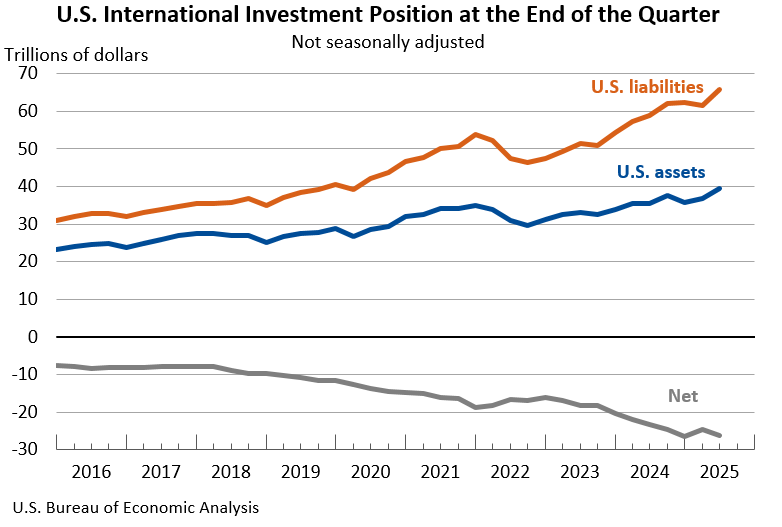Bureau of Economic Analysis
U.S. International Investment Position, 2nd Quarter 2025
The U.S. net international investment position, the difference between U.S. residents’ foreign financial assets and liabilities, was -$26.14 trillion at the end of the second quarter of 2025, according to statistics released today by the U.S. Bureau of Economic Analysis. Assets totaled $39.56 trillion, and liabilities were $65.71 trillion. At the end of the first quarter, the net investment position was -$24.65 trillion (revised).
Principal Federal Economic Indicators
Noteworthy
The Latest
July 2014 Trade Gap is $40.5 Billion
The U.S. monthly international trade deficit decreased in July 2014 according to the U.S. Bureau of Economic Analysis and the U.S. Census Bureau. The deficit decreased from $40.8 billion in June (revised) to $40.5 billion in July as exports increased more than imports. The previously published June deficit was $41.5 billion. The goods deficit decreased $0.2 billion from June to $60.2 billion in July; the services surplus was nearly unchanged…
Real Consumer Spending Falls in July
Personal Income rose 0.2 percent in July after rising 0.5 percent in June. Wages and salaries, the largest component of personal income, rose 0.2 percent in July after rising 0.4 percent in June.
Current-dollar disposable personal income (DPI), after-tax income rose 0.1 percent in July after rising 0.5 percent in June.
Real DPI, income adjusted for taxes and inflation, increased 0.1 percent in July after…
Personal Income and Outlays, July 2014
Personal income increased $28.6 billion, or 0.2 percent, and disposable personal income (DPI) increased $17.7 billion, or 0.1 percent, in July, according to the Bureau of Economic Analysis. Personal consumption expenditures (PCE) decreased $13.6 billion, or 0.1 percent. In June, personal income increased $67.1 billion, or 0.5 percent, DPI increased $62.9 billion, or 0.5 percent, and PCE increased $50.5 billion, or 0.4 percent, based on…
GDP Up in Second Quarter
Real gross domestic product (GDP) increased 4.2 percent in the second quarter of 2014, according to the “second” estimate released by the Bureau of Economic Analysis. In the first quarter, real GDP decreased 2.1 percent. The second-quarter growth rate was revised up 0.2 percentage point from the “advance” estimate released in July.
Second-quarter highlights
The upturn in real GDP growth was primarily driven by the following:…
Gross Domestic Product, 2nd quarter 2014 (second estimate); Corporate Profits, 2nd quarter 2014 (preliminary estimate)
Real gross domestic product -- the output of goods and services produced by labor and property located in the United States -- increased at an annual rate of 4.2 percent in the second quarter of 2014, according to the "second" estimate released by the Bureau of Economic Analysis. In the first quarter, real GDP decreased 2.1 percent. The GDP estimate released today is based on more complete source data than were available for the…
New Statistics on the Activities of U.S. Multinational Enterprises are Now Available
The Bureau of Economic Analysis has released preliminary 2012 statistics on the outward activities of multinational enterprises (AMNEs). Outward AMNE statistics cover the worldwide activities of U.S. multinational enterprises (MNEs). These statistics provide information on the finance and operations of U.S. MNEs, including balance sheet and income statement details, employment and employee compensation, sales, value added, capital…
Quarterly Gross Domestic Product by State, 2005–2013 (Prototype Statistics)
The quarterly GDP by state prototype statistics for 2005-2013 provide a more complete picture of economic growth across states as they evolve from quarter to quarter. The quarterly GDP by state statistics are released for 21 industry sectors and are released in both current dollars and inflation-adjusted chained (2009) dollars. Nondurable-goods manufacturing was the largest contributor to U.S. real GDP by state growth in the…
Quarterly Gross Domestic Product by State, 2005-2013 (prototype statistic)
Today, the U.S. Bureau of Economic Analysis released prototype statistics of quarterly gross domestic product (GDP) by state for 2005–2013. These new statistics provide a more complete picture of economic growth across states that can be used with other regional data to gain a better understanding of regional economies as they evolve from quarter to quarter.
U.S. Virgin Islands' Economy Shrinks for Third Consecutive Year
The estimates of Gross Domestic Product for the U.S. Virgin Islands show that real GDP, adjusted to remove price changes, decreased 5.4 percent in 2013. This was the third consecutive decline following decreases of 13.8 percent in 2012 and 7.5 percent in 2011.




